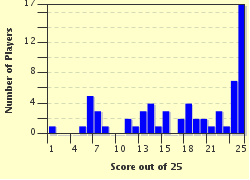Quiz Answer Key and Fun Facts
1. While many of the novel's characters are strongly written and quite memorable, the story follows the particular path of the Rev. Stephen Kumalo, so it is fair to consider him the 'main' character in the book. Of which religion is the Rev. Kumalo a clergyman?
2. The first paragraph of the novel, beginning "There is a lovely road that runs from Ixopo into the hills." is repeated in its exact entirety at a later point. Where does this direct repetition occur?
3. The Zulu word "Umfundisi" is used in many instances throughout the novel. To whom would this term be directed?
4. The Rev. Kumalo's son, Absalom Kumalo, is in prison awaiting trial for murder when we first meet him in the book (he is later convicted.) He has two co-defendants, one of whom is related to him. What relation is the co-defendant to Absalom Kumalo?
5. After arriving in Johannesburg, the Rev. Kumalo meets his brother, John Kumalo, who he has not seen for some time. While he figures most prominently as a firey orator against racial injustice, from what occupation does he make his living?
6. Though the most significant event on his trip to Johannesburg is the discovery of his son, Stephen Kumalo was actually summoned there for another reason. What was it?
7. Stephen Kumalo comes from the village of Ndotsheni, populated by Natives (black people.) Above the village there is a farm owned by a white family. What is this farm called?
8. Afrikaans, one of the two official languages of South Africa at the time of the novel's writing (English being the other) is most heavily concentrated in the northern region of the country. From which European language did Afrikaans develop?
9. Alan Paton is often compared to American novelist John Steinbeck. While there are numerous similarities between "Cry, the Beloved Country" and Steinbeck's "The Grapes of Wrath" in particular, there is one very specific and distinctive technique that both authors employ. What is it?
10. When James Jarvis goes through his son Arthur's possessions he notes the prevalence of a certain American president in his sons' books and writings. Which president is this?
11. One of the most forceful themes of the novel is Paton's pairing of the Native (black) peoples' condition with that of what?
12. While not as completely focused on the issue as, for instance, Chinua Achebe's novel "Things Fall Apart", "Cry, the Beloved Country" nonetheless gives serious attention to tribal decay. The novel takes place while the tribal population is undergoing a massive urban shift, with young people leaving the villages in droves. Other than the slums of cities, where is the main destination for young males in particular who leave their villages?
13. James Jarvis and Stephen Kumalo have both lost their sons. In what way is this signifigant?
14. After Stephen Kumalo has returned to Ndotsheni at the end of the novel, he approaches the village chief to request assistance in revitalizing the village. The chief demurs. Who offers help?
15. Stephen Kumalo's sister Gertrude has been supporting herself via illegal means. From which of the following criminal enterprises did she earn her livelihood?
16. When Stephen Kumalo tries to track down his son, he finds that at one point he was sent to a reformatory. Considering he himself once ran a reformatory in the region he describes in the book, it is almost certain Paton drew on his own experience in his descriptions of the reformatory. What reformatory did Paton actually run in his own life?
17. In addition to being an author, Alan Paton was politically active. In fact, he was a founding member of a political party in South Africa. Which party was this?
18. On the day Absolom is scheduled to be executed, Stephen Kumalo goes into the mountains around Ndotsheni to pray. Who does he meet while there?
19. After returning to Ndotsheni, Stephen Kumalo encounters Arthur Jarvis' son. Later, as a result of his conversation with the boy, the Jarvis farm sends a gift to the village. What is this gift?
20. While in Johanesburg, Stephn Kumalo stays with the Rev. Msimangu. At one point, Msimangu confides his fear that "by the time the white man learns to love, the black man will have _______________." ?
21. From which point of view does the narrator speak in the novel? (This qustion refers speficially to the narrator - not any particular character that may dominate the novel at specific points.)
22. When Stephen Kumalo returns from Johannesburg to Ndotsheni, he brings two people with him. Who are these people?
23. At several times at the end of the book, something happens in Kumalo's church. What happens during the confirmation ceremony, and when Stephen Kumalo and Arthur Jarvis meet?
24. Napoleon Letsitsi, an agricultural expert hired by James Jarvis to assist the people of Ndotsheni, states that he works for whom?
25. Of the following, which is NOT a major recurring motif in the novel?
Source: Author
Lonagan
This quiz was reviewed by FunTrivia editor
agony before going online.
Any errors found in FunTrivia content are routinely corrected through our feedback system.

